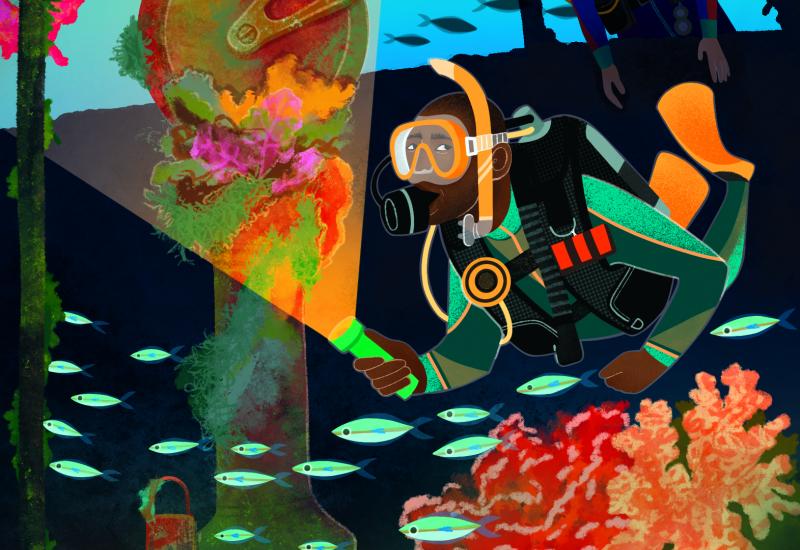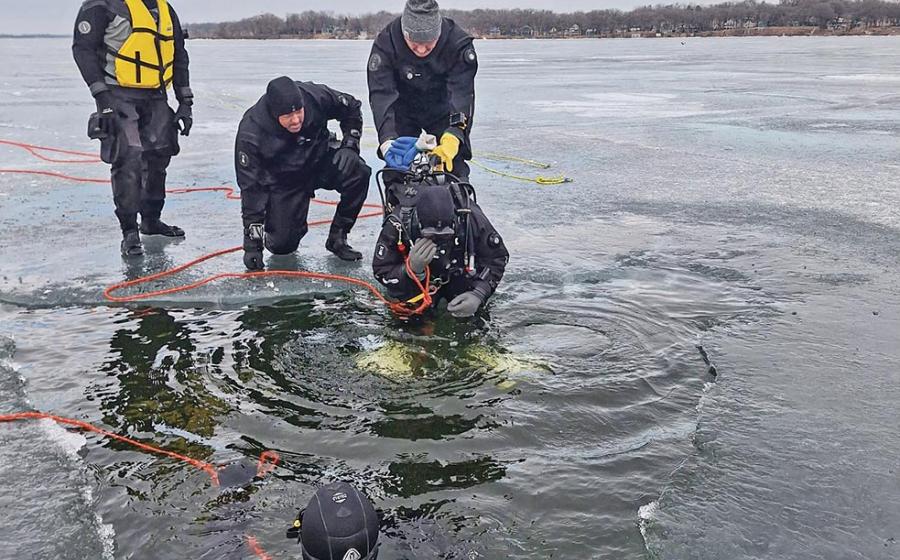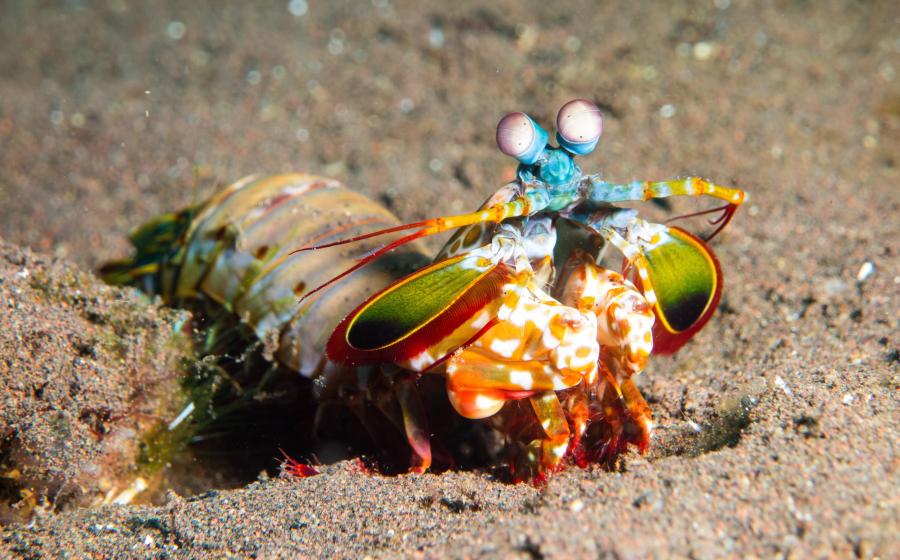Downtown Aquarium, Denver

By Jennie Lay
Photo by Doug Sloss
I'm on the inside, looking out through the 11-inch glass at a dozen wiggly, pint-sized campers in matching green T-shirts. They make goofy faces, frantically wave and make signals with their hands that beg an equally silly response. Inside the 400,000-gallon Shipwreck exhibit, aka the Shark Tank, at the Downtown Aquarium in Denver, I'm a diver on display. But before I can act on my big-kid impulse to indulge the little ones, two ferocious-looking sand tiger sharks glide between me and my admirers.
I'm distracted by the animals' mouths agape, flashing me rows of askew, razor-edged teeth. Although that slack-jawed look is regular sand tiger style, I'm paying extra-close attention to what's happening just beyond my bubbles. With a swish of their six-foot bodies, the sand tigers swoop in over my head and do an about-face at a wall. For a mesmerizing moment as I lurk in a low-lying trench, I peer deep into one shark's beady eye before he heads for another lap around the tank. At one mile above sea level and 1,000 miles from the nearest ocean, I can't believe I'm holding court with specimens of magnificent species in tropical conditions--in the heart of the Rockies.
It's all part of the Downtown Aquarium's guest dive program, where the attraction is interaction with a variety of animals in the tanks that would never share the same space in the ocean--sawfish from Australia, sand tigers from North Carolina, green turtles from Hawaii and zebra sharks from the Western Pacific. The Aquarium started this guided adventure three years ago, in conjunction with a local dive operator, and since then, more than 3,000 divers have taken the plunge. The Aquarium's two-tank dive includes swims in the Under the Sea exhibit followed by a shark dive in the Shipwreck exhibit--although most divers pick a one-tank experience. On Saturdays and Sundays year-round, a maximum of six divers can dive in. It's an opportunity to hang out underwater, blow some bubbles and enjoy exceptional fish interaction in crystal-clear water.
Part of the dive package includes getting a behind-the-scenes look at aquarium operations. So, after checking in, we venture past giant filtration systems in the bowels of the building, then ride up the service elevator and circulate above the exhibits. We see the crane that runs on an overhead track to move big fish and turtles between tanks. The crane is also used with special harnesses to help paraplegic and quadriplegic divers in and out of the Under the Sea exhibit.
On our two-tank dive, we warm up with a plunge in the 200,000-gallon Under the Sea tank. It features encounters with a 300-pound Queensland grouper; a 65-year-old Pacific green turtle; a group of hefty green moray eels; nurse sharks; tarpon and many other fish species. Our guides are Todd Hall, Downtown Aquarium's dive director, who originated these dives, and Shane Taylor, general manager of A-1 Scuba and Travel Center, the dive shop the aquarium partners with. "In the ocean, you've got to go looking for things," Taylor says during our dive briefing. "Here, they come to you. They're not bashful. This is their house." The rule is: no touching or feeding the animals. We're here only to observe and learn--even when that giant, puppy-dog-like grouper repeatedly edges in on you for attention. But if you're lucky enough to find a stray shark's tooth while you're underwater (assuming you can peel your eyes off the fish long enough to scour the floor), your guides encourage you to keep it as a souvenir. All they ask, if you find a tooth, is that you make an official donation (by putting money in the lock box by the guest locker room) to the Shark Conservation Program. The donations are used to help fund field research projects on sharks.
Back inside the Shark Tank, it's like a scene out of an animated film about the sea: A 12-foot green sawfish with its curious snout almost half that size meanders its way along the gravelly floor, and a feisty Pacific green sea turtle swoops in to nip at a sandbar's dorsal fins. Barracudas stalk the tank's perimeter, while a guitarfish minds his bottom-feeding business. And still, on the other side of the glass, the kids seem more enthralled by the divers, as if we're the main attraction. I giggle through my regulator, then, finally acting on my big-kid impulse--and trying hard not to upset any of the 20-plus sharks I'm diving with--I flash them a small, friendly wave.
InDepth
Getting Around: The Aquarium is at 700 Water St., just off Interstate 25. From the north, take I-25 South to Exit 211 (23rd Avenue), go left at the stop sign, then turn right onto Water Street. From the south, take I-25 North, exit at 23rd Avenue, then veer right and the aquarium is on your right. From Downtown Denver (LoDo), take 15th Street west to Platte Street and turn left. Platte Street becomes Water Street and the aquarium is on your left.
Dive Conditions: The temperature in the Under the Sea exhibit is in the mid-70s, with a maximum depth of 18 feet, while the Shark Tank temperature is in the low 70s, with a maximum depth of 22 feet. Visibility is crystal-clear. To avoid exhibit contamination, all equipment is provided onsite, including 3mm or 5mm wetsuits, BCs, regulators, filled tanks, gloves, beanies, fins and weights. Well-scrubbed personal masks and cameras are permitted. Fish dives start at 11:30 a.m.; shark dives at 12:30 p.m.
Dive Outfitters: A-1 Scuba and Travel Center (a1scuba.com) offers Under the Sea and Shark Tank dives. Each costs $175 and includes aquarium admission for you and a guest, guides, all equipment, fish ID booklet, shark conservation information, free restaurant appetizer, T-shirt and validated parking. Snorkeling ($75) is for anyone 6 and older. Visit divedowntown.com, or call (303) 789-2450.

By Jennie Lay
Photo by Doug Sloss
I'm on the inside, looking out through the 11-inch glass at a dozen wiggly, pint-sized campers in matching green T-shirts. They make goofy faces, frantically wave and make signals with their hands that beg an equally silly response. Inside the 400,000-gallon Shipwreck exhibit, aka the Shark Tank, at the Downtown Aquarium in Denver, I'm a diver on display. But before I can act on my big-kid impulse to indulge the little ones, two ferocious-looking sand tiger sharks glide between me and my admirers.
I'm distracted by the animals' mouths agape, flashing me rows of askew, razor-edged teeth. Although that slack-jawed look is regular sand tiger style, I'm paying extra-close attention to what's happening just beyond my bubbles. With a swish of their six-foot bodies, the sand tigers swoop in over my head and do an about-face at a wall. For a mesmerizing moment as I lurk in a low-lying trench, I peer deep into one shark's beady eye before he heads for another lap around the tank. At one mile above sea level and 1,000 miles from the nearest ocean, I can't believe I'm holding court with specimens of magnificent species in tropical conditions--in the heart of the Rockies.
It's all part of the Downtown Aquarium's guest dive program, where the attraction is interaction with a variety of animals in the tanks that would never share the same space in the ocean--sawfish from Australia, sand tigers from North Carolina, green turtles from Hawaii and zebra sharks from the Western Pacific. The Aquarium started this guided adventure three years ago, in conjunction with a local dive operator, and since then, more than 3,000 divers have taken the plunge. The Aquarium's two-tank dive includes swims in the Under the Sea exhibit followed by a shark dive in the Shipwreck exhibit--although most divers pick a one-tank experience. On Saturdays and Sundays year-round, a maximum of six divers can dive in. It's an opportunity to hang out underwater, blow some bubbles and enjoy exceptional fish interaction in crystal-clear water.
Part of the dive package includes getting a behind-the-scenes look at aquarium operations. So, after checking in, we venture past giant filtration systems in the bowels of the building, then ride up the service elevator and circulate above the exhibits. We see the crane that runs on an overhead track to move big fish and turtles between tanks. The crane is also used with special harnesses to help paraplegic and quadriplegic divers in and out of the Under the Sea exhibit.
On our two-tank dive, we warm up with a plunge in the 200,000-gallon Under the Sea tank. It features encounters with a 300-pound Queensland grouper; a 65-year-old Pacific green turtle; a group of hefty green moray eels; nurse sharks; tarpon and many other fish species. Our guides are Todd Hall, Downtown Aquarium's dive director, who originated these dives, and Shane Taylor, general manager of A-1 Scuba and Travel Center, the dive shop the aquarium partners with. "In the ocean, you've got to go looking for things," Taylor says during our dive briefing. "Here, they come to you. They're not bashful. This is their house." The rule is: no touching or feeding the animals. We're here only to observe and learn--even when that giant, puppy-dog-like grouper repeatedly edges in on you for attention. But if you're lucky enough to find a stray shark's tooth while you're underwater (assuming you can peel your eyes off the fish long enough to scour the floor), your guides encourage you to keep it as a souvenir. All they ask, if you find a tooth, is that you make an official donation (by putting money in the lock box by the guest locker room) to the Shark Conservation Program. The donations are used to help fund field research projects on sharks.
Back inside the Shark Tank, it's like a scene out of an animated film about the sea: A 12-foot green sawfish with its curious snout almost half that size meanders its way along the gravelly floor, and a feisty Pacific green sea turtle swoops in to nip at a sandbar's dorsal fins. Barracudas stalk the tank's perimeter, while a guitarfish minds his bottom-feeding business. And still, on the other side of the glass, the kids seem more enthralled by the divers, as if we're the main attraction. I giggle through my regulator, then, finally acting on my big-kid impulse--and trying hard not to upset any of the 20-plus sharks I'm diving with--I flash them a small, friendly wave.

InDepth
Getting Around: The Aquarium is at 700 Water St., just off Interstate 25. From the north, take I-25 South to Exit 211 (23rd Avenue), go left at the stop sign, then turn right onto Water Street. From the south, take I-25 North, exit at 23rd Avenue, then veer right and the aquarium is on your right. From Downtown Denver (LoDo), take 15th Street west to Platte Street and turn left. Platte Street becomes Water Street and the aquarium is on your left.
Dive Conditions: The temperature in the Under the Sea exhibit is in the mid-70s, with a maximum depth of 18 feet, while the Shark Tank temperature is in the low 70s, with a maximum depth of 22 feet. Visibility is crystal-clear. To avoid exhibit contamination, all equipment is provided onsite, including 3mm or 5mm wetsuits, BCs, regulators, filled tanks, gloves, beanies, fins and weights. Well-scrubbed personal masks and cameras are permitted. Fish dives start at 11:30 a.m.; shark dives at 12:30 p.m.
Dive Outfitters: A-1 Scuba and Travel Center (a1scuba.com) offers Under the Sea and Shark Tank dives. Each costs $175 and includes aquarium admission for you and a guest, guides, all equipment, fish ID booklet, shark conservation information, free restaurant appetizer, T-shirt and validated parking. Snorkeling ($75) is for anyone 6 and older. Visit divedowntown.com, or call (303) 789-2450.











